What Are the Unique Flora and Fauna Found Only on Certain Nepalese Treks?
What are the unique flora and fauna found only on certain Nepalese treks? Nepal is renowned for its breathtaking landscapes, towering mountains, and vibrant cultures, but it is also a hidden gem for nature enthusiasts. As trekkers traverse the trails of this majestic country, they encounter a unique array of flora and fauna that can be found nowhere else on Earth. From the striking Himalayan Monal to the elusive red panda, trekkers can spot remarkable species like the blue sheep and the elusive snow leopard in the Annapurna region, or the vibrant rhododendron forests of Ghorepani. Each trek offers a chance to discover these extraordinary species that highlight Nepal’s rich biodiversity. This exploration of Nepal’s natural treasures not only enhances the trekking experience but also underscores the importance of conservation efforts to protect these unique habitats and the wildlife that calls them home.
Unique Flora and Fauna Along the Trails: Discovering Nepal’s Natural Treasures
Nepal is a treasure trove of natural beauty, where the majestic Himalayas meet diverse ecosystems. As trekkers wander along the trails, they are greeted not only by breathtaking landscapes but also by a remarkable array of unique flora and fauna. Each trek offers a chance to encounter species that are often found nowhere else on Earth, making every journey a memorable adventure into nature.
One of the most striking plants found in Nepal is the Himalayan Monal, or Danphe, which dazzles with its vibrant colors. This bird, the national symbol of Nepal, can often be spotted in the Annapurna region, adding a splash of life to the stunning scenery. Similarly, trekkers in the Langtang Valley might catch sight of the elusive Ghoral, a graceful goat-antelope that expertly navigates steep mountain slopes. The experience of seeing these animals in their natural habitats not only enriches the trekking experience but also highlights the importance of conservation efforts in preserving these unique species.
Additionally, areas like the Shuklaphanta National Park are home to rare wildlife, including the Sangai, or swamp deer, which thrive in lush wetlands. Trekkers can also encounter playful Rhesus macaques along the trekking routes, providing delightful moments of interaction. In the high altitudes, the Snow Cock presents a challenging yet rewarding sight for birdwatchers. Each species adds to the rich tapestry of life in Nepal, showcasing the incredible biodiversity that thrives in this region.
Furthermore, trekkers in the Langtang region can learn about various medicinal plants, many of which are integral to local traditions and healing practices. The chance to understand and appreciate the cultural significance of these plants deepens the connection between nature and the communities that depend on it. With each step along the trails, trekkers not only witness the beauty of Nepal’s flora and fauna but also become part of a larger story of conservation and respect for the environment.
Exploring the unique flora and fauna of Nepal is more than just a trek; it is an opportunity to connect with nature, support conservation efforts, and embrace the wonder of the natural world. Whether spotting the vibrant Danphe or observing the agile Ghoral, every moment in Nepal’s wilderness is a reminder of the planet’s incredible biodiversity and the importance of protecting it for future generations.
Here are some of the unique flora and fauna you can discover along specific trails:
Rhododendrons on the Ghorepani-Poon Hill Trek
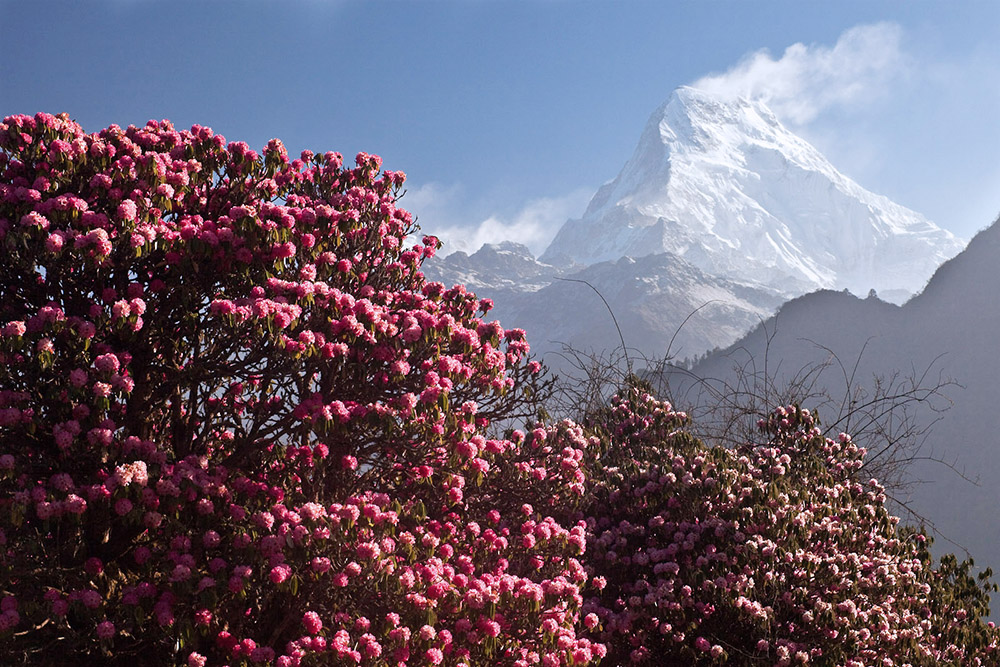
The Ghorepani-Poon Hill Trek is well-known for its incredible rhododendron forests, especially during the spring season. Rhododendrons are the national flower of Nepal, and when they bloom, they transform the landscape into a breathtaking sight. From March to May, the forests along this trek are covered in bright red, pink, and sometimes white rhododendron flowers, creating a natural carpet of colors.
As you walk through the trails, you’ll notice how the rhododendron trees can grow quite tall, some reaching heights of up to 30 meters (about 100 feet). These aren’t small bushes but large trees with thick branches, and when they bloom, they fill the air with a fresh, sweet fragrance. The sight of entire hillsides blanketed with these vibrant flowers is a major highlight of the trek.
Rhododendrons are not just beautiful; they also have cultural importance in Nepal. Locally known as “Lali Gurans”, they are often used in festivals, and the flowers are even made into local drinks and medicines. For trekkers, seeing these flowers in full bloom adds a special touch to the journey.
As you reach higher altitudes on the Ghorepani-Poon Hill Trek, especially near Poon Hill itself, the rhododendron forests create a colorful contrast against the snow-capped mountains in the background. This combination of blooming rhododendrons and panoramic views of the Annapurna and Dhaulagiri ranges makes the trek unforgettable. The trek through these forests is one of the best ways to experience the beauty of Nepal’s natural landscapes up close.
Red Panda in the Langtang Valley

The Langtang Valley is a special place for nature lovers because it is home to one of the world’s rarest animals—the red panda. The red panda is an endangered animal that looks a bit like a small bear with a reddish-brown coat, a long, bushy tail, and big round eyes. It’s known for being shy and difficult to spot, which is why seeing one on a trek is considered very lucky.
In Langtang National Park, the red panda lives in forests filled with bamboo. This is its favorite food, and it spends a lot of time munching on bamboo leaves. Trekkers who move quietly through the forest sometimes get the chance to see this cute and elusive animal resting in the trees or moving through the bamboo.
Because the red panda is endangered, it is important to protect its home. Langtang National Park helps with this by making sure the forests stay healthy and safe for the red panda and other wildlife. Seeing a red panda in its natural home is a rare and exciting experience that many trekkers hope for when they visit the Langtang Valley.
Not only does the Langtang Valley offer stunning views of mountains and landscapes, but the possibility of spotting a red panda makes it a unique adventure for those interested in Nepal’s amazing wildlife.
Musk Deer in the Annapurna Circuit
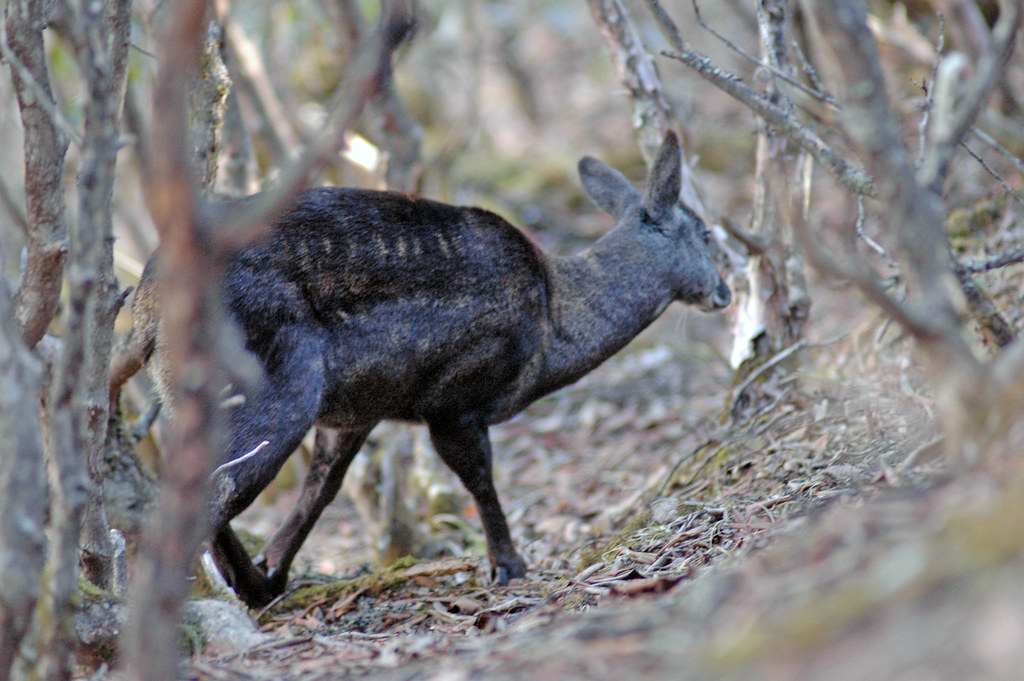
The Annapurna Circuit is famous for its incredible mountain views, but it’s also home to the rare and secretive musk deer. This unique deer is known for being shy and hard to spot. It lives in the high-altitude forests of the Himalayas and is especially common in areas like Manang and Pisang along the Annapurna Circuit.
Musk deer are smaller than regular deer, with long, pointed ears and a thick, dark brown coat that helps them blend into their surroundings. Unlike other deer, male musk deer don’t have antlers. Instead, they have two small, sharp tusks that give them a very distinct look. These deer are called “musk” deer because the males produce a strong-smelling substance called musk, which is used in perfumes and traditional medicines. Unfortunately, because of this, they are often hunted and are now considered endangered.
While trekking through the higher sections of the Annapurna Circuit, especially in the early mornings or evenings, you may be lucky enough to catch a glimpse of one. They are usually very quiet and move quickly through the forest, so spotting one can feel like a special reward during your trek.
The musk deer is an important part of Nepal’s wildlife, and efforts are being made to protect them from hunting and habitat loss. Seeing a musk deer in the wild is a rare and exciting experience, adding a touch of wildlife magic to the already beautiful landscapes of the Annapurna Circuit.
Himalayan Blue Poppy on the Upper Dolpo Trek
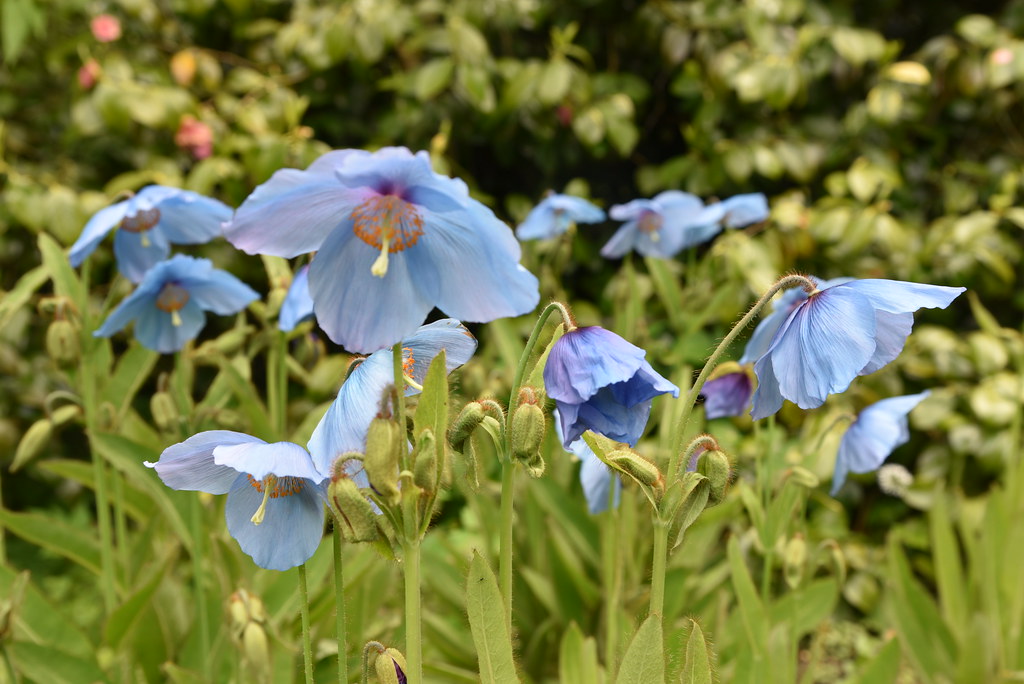
The Upper Dolpo Trek is known for its remote and wild beauty, and one of the rarest treasures you can find here is the Himalayan blue poppy. This delicate, bright blue flower only grows at very high altitudes, usually above 3,500 meters (11,500 feet), and is one of the most special plants you can see while trekking in Nepal.
The Himalayan blue poppy blooms during the summer season, from June to August, when the snow melts, and the mountain meadows come to life. The flower has large, soft petals and a striking blue color, which stands out against the rocky, rugged landscape of Upper Dolpo. Because it only grows in such harsh conditions, finding it feels like discovering a hidden gem in the mountains.
Many trekkers consider seeing the blue poppy to be a highlight of their journey. It’s not just its beauty that makes it special, but also the fact that it is very rare and only found in a few places in the world. The flower is also important in local culture and traditional medicine.
For those trekking in Upper Dolpo, spotting the Himalayan blue poppy is a reminder of how nature can thrive even in the toughest conditions. It adds a touch of color and wonder to an already amazing trek, making the experience even more memorable.
Snow Leopards in the Kangchenjunga Region

The Kangchenjunga Conservation Area is one of the last places on Earth where the rare and mysterious snow leopard still roams free. Snow leopards are known as “ghosts of the mountains” because they are so hard to see. They live in the high, cold mountains of the Himalayas, blending perfectly into the rocky, snowy landscape. In the Kangchenjunga region, these beautiful big cats move silently through the steep, rugged terrain, making sightings incredibly rare.
Snow leopards are an endangered species, meaning there aren’t many left. However, thanks to conservation efforts in the Kangchenjunga Conservation Area, their numbers are slowly recovering. Local communities, wildlife organizations, and the government are all working together to protect these animals from poaching and habitat loss. They also help people learn how to live alongside snow leopards without conflict. One way they do this is by providing compensation for any livestock lost to snow leopards, so people are less likely to harm them in return.
Although spotting a snow leopard is extremely rare, the possibility of seeing one makes the trek through the Kangchenjunga region even more exciting. Knowing that these elusive cats are still out there, roaming the same trails and mountains you’re trekking on, adds a sense of wonder and adventure to the experience. Even if you don’t see one, just being in snow leopard territory is a thrilling experience for nature lovers and trekkers alike.
Biodiversity of the Makalu Barun National Park

Makalu Barun National Park is one of the most amazing places in Nepal for anyone who loves nature. This park is a hotspot for both plants and animals, making it a paradise for nature lovers and trekkers. It is home to a wide variety of life, including many rare species.
One of the special animals you might find here is the clouded leopard. This beautiful cat is known for its unique spotted coat and is a skilled climber, often found resting on tree branches. Another rare animal in the park is the Himalayan black bear, which has thick fur and can be seen foraging for food in the forests. Both of these animals are elusive, so spotting them is a special treat for trekkers.
In addition to these fascinating animals, Makalu Barun National Park is a botanist’s dream. The park has over 3,000 species of flowering plants, including many that are unique to the area. As you trek through the park, you’ll see colorful wildflowers, lush forests, and even alpine plants that thrive in the high altitudes. The diverse habitats range from subtropical forests at lower elevations to snowy peaks above, creating a perfect environment for various plants and animals.
The park is also home to many other wildlife species, including red pandas, musk deer, and various birds. The mix of different ecosystems in Makalu Barun National Park makes it one of the richest areas for biodiversity in Nepal. For trekkers, experiencing this incredible variety of life is not just about the adventure; it’s also about appreciating the beauty and complexity of nature in one of the world’s most stunning mountain landscapes.
Tibetan Wolf in the Mustang Region
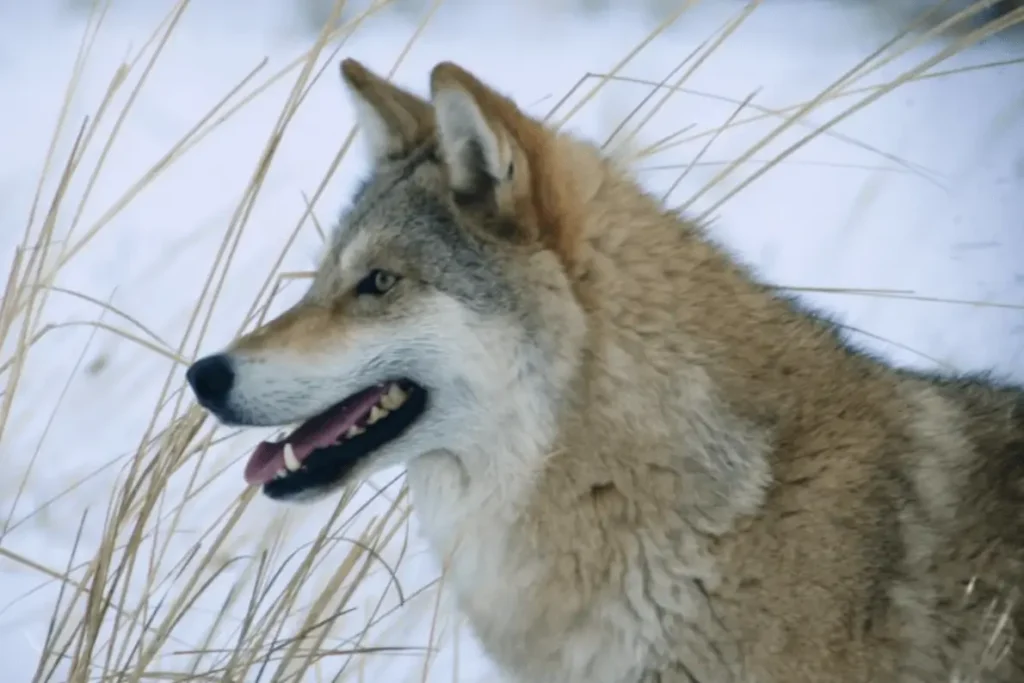
The Mustang region of Nepal is known for its stunning landscapes and unique wildlife, including the Tibetan wolf. This remarkable animal is specially adapted to survive in the harsh conditions of the high Himalayas, where the weather can be very dry and cold.
Tibetan wolves have thick fur to keep them warm, and they are slightly smaller than the wolves you might find in forests. Their color usually ranges from gray to light brown, which helps them blend into the rocky terrain. They are known for their sharp eyes and keen sense of smell, which they use to hunt for food. In Mustang, these wolves primarily hunt small animals like rodents and hares, making them important predators in the ecosystem.
Because the Mustang region is remote and not heavily populated, Tibetan wolves can roam freely, but they are still considered a vulnerable species due to habitat loss and hunting. Trekking in this area gives you a chance to see these fascinating animals in their natural habitat, but spotting one can be challenging since they are quite shy and often avoid humans.
The rugged beauty of Mustang, with its high-altitude deserts and dramatic landscapes, creates a perfect setting for these wolves. Trekkers who are lucky enough to catch a glimpse of a Tibetan wolf will not only be amazed by its beauty but will also gain a deeper appreciation for the resilience of wildlife in such a challenging environment. The experience of seeing a Tibetan wolf in the wild adds a special touch to the adventure in the Mustang region, making it a memorable part of the trek.
Danphe (Himalayan Monal) in the Annapurna Region
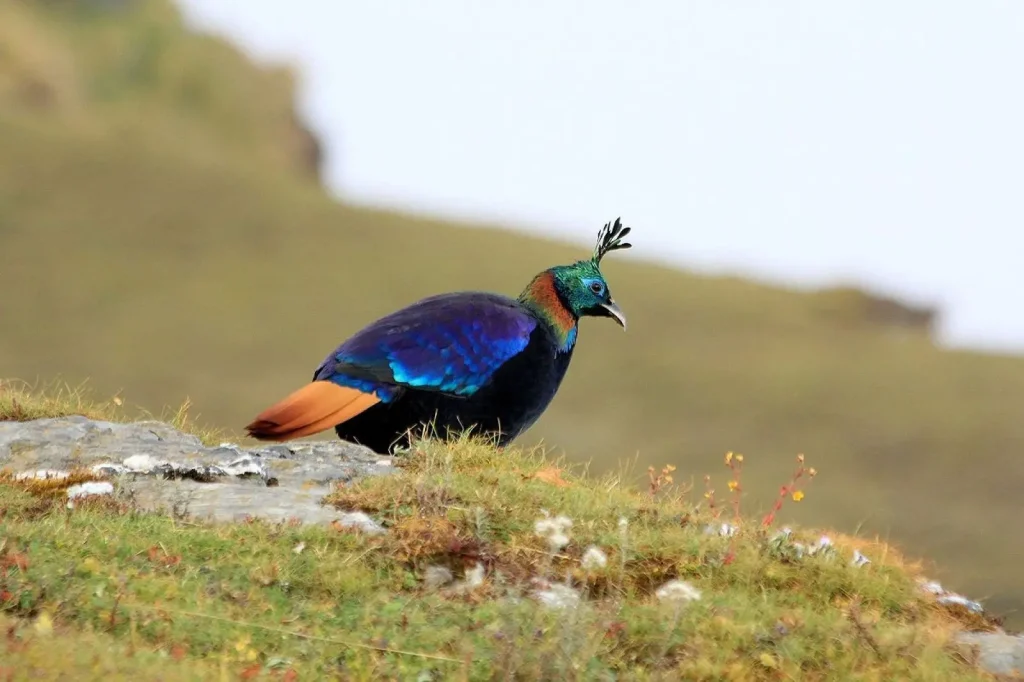
The Danphe, also called the Himalayan Monal, is a beautiful bird that is considered the national bird of Nepal. The males have bright and colorful feathers, showing shades of green, blue, red, and gold. They are truly a sight to behold against the backdrop of the majestic mountains. The Danphe lives in the forests and meadows of the Annapurna region, where it can often be seen foraging for food among the plants. They mainly eat seeds, fruits, and insects, which they find on the ground.
During the spring season, male Danphes display their colors more prominently to attract females. Their mating dance is a fascinating spectacle, with the males puffing up their feathers and strutting around to show off. Trekking in this region during spring gives you a higher chance of spotting these birds as they come out to find mates and food. If you’re lucky enough to see a Danphe, it will be one of the highlights of your trek, adding to the beauty of the already stunning scenery.
Photographers and birdwatchers particularly love the Danphe. If you plan to trek in the Annapurna region, make sure to bring your camera and binoculars. The sight of a Danphe in its natural habitat, surrounded by blooming flowers and towering peaks, is something you will never forget. So, keep your eyes peeled and listen for their calls, which can often lead you to their location.
Ghoral (Himalayan Goral) in the Langtang Valley
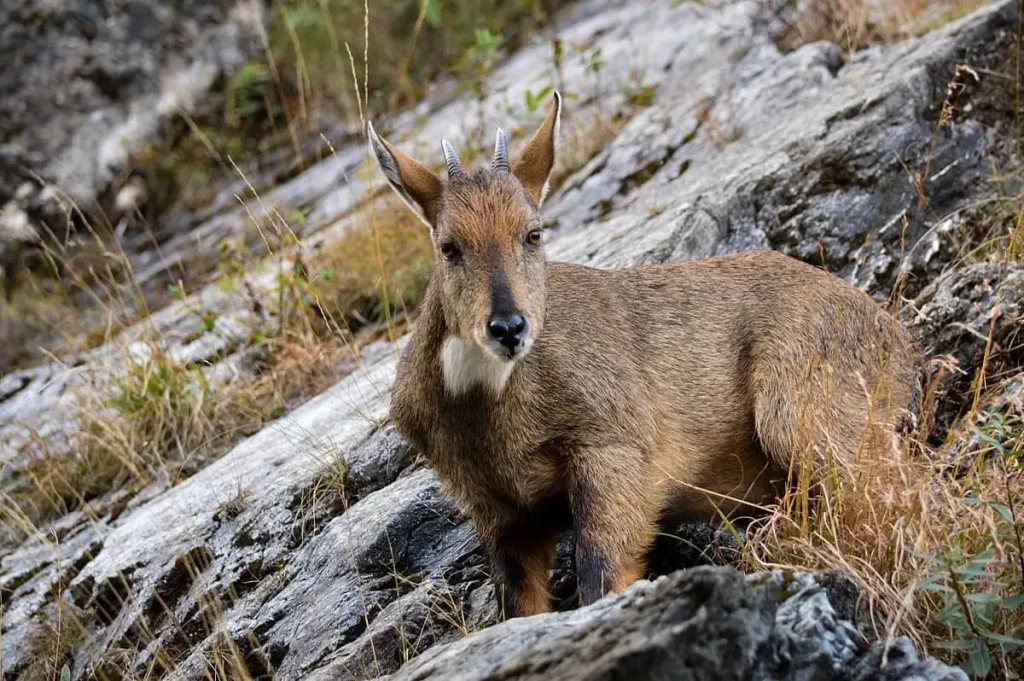
The Ghoral, or Himalayan Goral, is a type of goat-antelope that lives in the steep and rocky areas of the Himalayas. You can find them in the Langtang Valley, where they are well adapted to the rugged environment. Ghorals have strong legs and sharp hooves that help them climb steep slopes and navigate rocky terrains. Their fur is typically a brown or gray color, which helps them blend into their surroundings, making them less visible to predators.
These animals are usually seen in small groups, often consisting of a few females and their young. Males tend to be more solitary and can sometimes be spotted on their own. They are herbivores, mainly feeding on grass, leaves, and shrubs found in their habitat. When trekking in the Langtang Valley, you might encounter a group of ghorals grazing or resting on a sunny rock. Watching them move gracefully through the rocky landscape is an exciting experience for trekkers.
The Ghoral is a shy animal, so you’ll need to be quiet and patient if you want to see them. As you walk along the trails, take a moment to stop and look around. The reward of spotting a Ghoral in the wild is worth the wait. Their agility and beauty remind us of the incredible wildlife that inhabits these high-altitude areas.
Sangai (Swamp Deer) in Shuklaphanta National Park

The Sangai, also known as the swamp deer, is a rare species that lives in the lowland areas of Nepal, especially in Shuklaphanta National Park. This deer is known for its long, thin legs and large antlers, which can grow very big, especially in males. The Sangai prefers wetland areas, where it can find plenty of grass and water. The lush environment of Shuklaphanta makes it an ideal home for these beautiful creatures.
In the park, you can often see Sangai grazing peacefully near the wetlands, surrounded by tall grasses and bushes. They usually move in small groups, which helps them stay safe from predators. The park is a great place to observe these deer up close, and many visitors enjoy taking photos of them in their natural habitat. The sight of a Sangai in the wild is truly special, especially for wildlife enthusiasts.
The Sangai is also important for local conservation efforts. Its population has decreased over the years due to habitat loss and hunting. By visiting Shuklaphanta National Park, you support the efforts to protect this beautiful animal and its habitat. Trekking in this area gives you the chance to see not only the Sangai but also other wildlife and plants that thrive in the unique ecosystem of the Terai region.
Rhesus Macaque Along the Trekking Routes
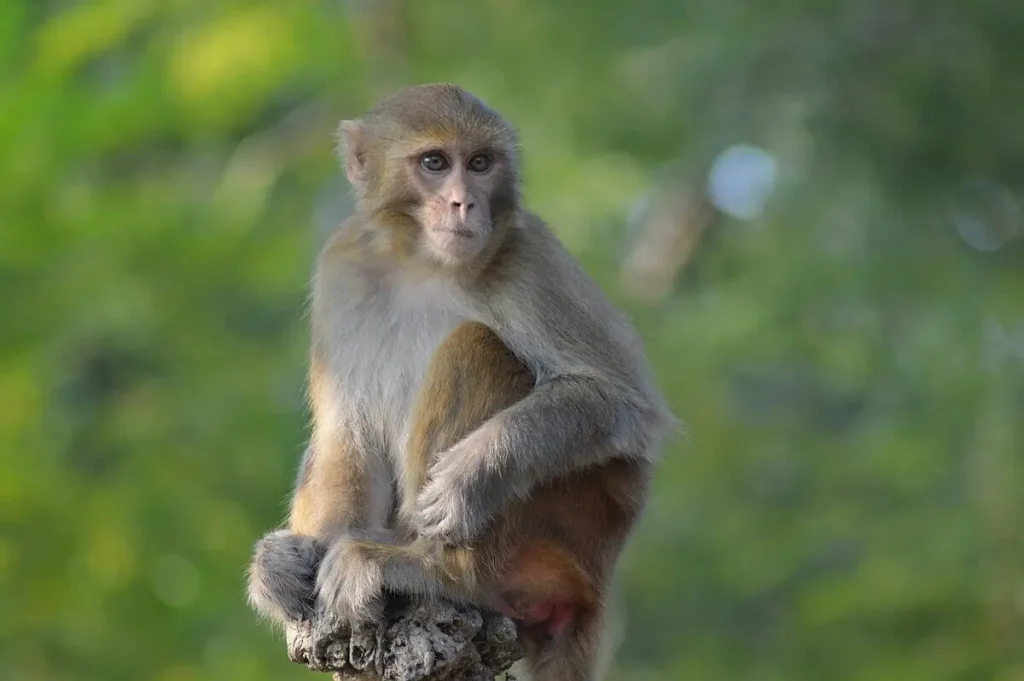
The Rhesus macaque is a lively and social monkey that you might encounter along many trekking routes in Nepal, especially in the lower valleys. These monkeys are known for their playful behavior and are often seen in groups. They have a light brown coat and a characteristic face with pink skin around their noses. Rhesus macaques are very curious and are always exploring their surroundings, which makes them fun to watch.
While trekking, you might see these monkeys swinging from tree branches or playing with each other on the ground. They are very social animals and often communicate with loud calls and playful gestures. If you sit quietly and watch, you may see a group of Rhesus macaques grooming each other or chasing one another in a playful manner. Their energetic antics can bring a smile to any trekker’s face and make your journey even more enjoyable.
However, it’s important to remember that while these monkeys can be entertaining, they are still wild animals. If you see Rhesus macaques, it’s best not to feed them or approach them too closely. They are used to human presence and may become bold if they think they can get food. Observing them from a distance allows you to appreciate their behavior without disturbing their natural habits.
Crested Serpent Eagle in the Hills
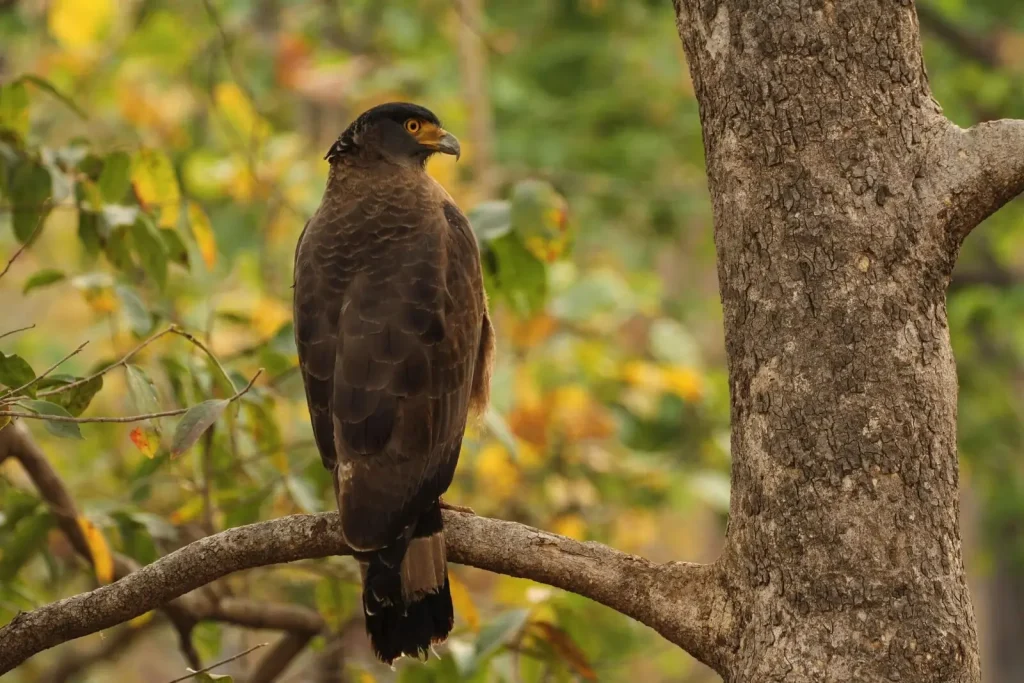
The Crested Serpent Eagle is a stunning bird of prey that you might spot soaring above the hills during your trek. This eagle is easily recognizable by its distinctive crest and dark brown feathers. With its keen eyesight, the Crested Serpent Eagle can spot small animals from great heights. It mainly feeds on snakes and small mammals, making it an important predator in the ecosystem.
As you trek through forested areas, keep an eye on the sky. You might see the Crested Serpent Eagle gliding gracefully, searching for its next meal. These eagles are not only beautiful but also play a vital role in maintaining the balance of nature. They help control the population of small animals and snakes, contributing to the health of their habitat.
Listening for their calls can also help you locate them. The sound they make is quite distinct, and if you hear it, look up to see if you can spot one in flight. Watching a Crested Serpent Eagle soar above the hills is a memorable experience, especially for birdwatchers. These moments connect trekkers to the wild beauty of the Himalayas and remind us of the incredible wildlife that shares this breathtaking landscape.
Various Medicinal Plants in the Langtang Region

The Langtang region is rich in various medicinal plants that have been used by local communities for generations. Some of these plants are known for their healing properties and are used in traditional medicine. Trekking through this area, you may come across plants like yarsagumba (cordyceps) and shatavari, both of which are highly valued for their health benefits.
Yarsagumba is a unique fungus that grows on the larvae of caterpillars and is believed to boost energy and improve stamina. It has become popular not just in Nepal but around the world for its medicinal properties. Shatavari, on the other hand, is a plant known for its use in Ayurvedic medicine to support women’s health. Learning about these plants while trekking allows you to appreciate the local knowledge and traditions surrounding natural remedies.
The locals often share their knowledge about these plants with trekkers, explaining how they are used and their significance in daily life. This connection to nature adds depth to your trekking experience. By understanding the medicinal plants and their uses, you gain insight into the rich cultural heritage of the region, making your journey even more meaningful.
Snow Cock in the High Altitudes
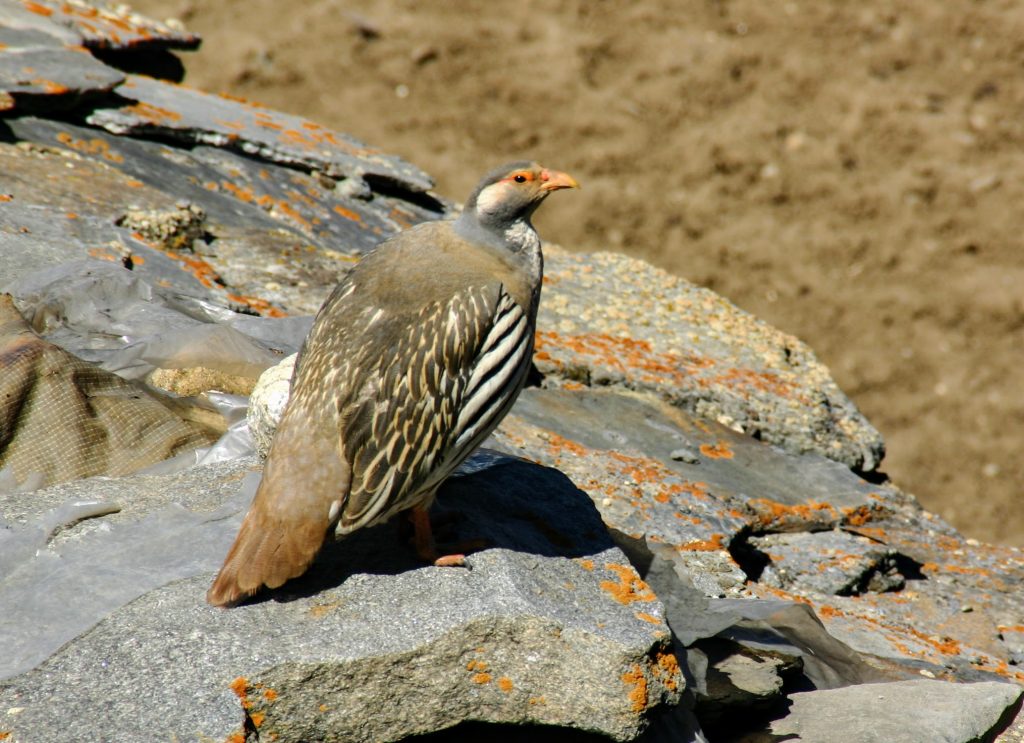
The Snow Cock is a large game bird that lives in the high-altitude areas of Nepal. You can find them in places like the Annapurna and Langtang regions, where the rugged terrain and cooler climate suit them well. Snow Cocks are known for their beautiful plumage, which can be a mix of gray, brown, and white. They are also recognized for their distinctive calls, which can be heard echoing across the mountains.
These birds prefer to stay hidden among the rocky outcrops and thick shrubs, which makes spotting them a bit challenging. They are more active during the early morning and late afternoon, so if you are trekking in these areas, be sure to keep an eye out during these times. The thrill of catching a glimpse of a Snow Cock in the wild is a rewarding experience for trekkers, as they are not only beautiful but also a part of the unique ecosystem in the high Himalayas.
Snow Cocks are an important part of the local wildlife and contribute to the biodiversity of the region. They are also a favorite among birdwatchers, and many trekkers hope to see them during their journey. The experience of observing a Snow Cock in its natural habitat, surrounded by the majestic mountains, adds an unforgettable touch to your trekking adventure.
Exploring the unique flora and fauna along Nepal’s trekking routes is not just about witnessing nature’s beauty; it is an opportunity to engage with the rich biodiversity that thrives in this mountainous paradise. Each encounter with a rare species, whether it’s the mesmerizing Danphe or the secretive snow leopard, deepens trekkers’ appreciation for the delicate ecosystems that exist within the country. As visitors immerse themselves in these experiences, they become part of a broader narrative of conservation and respect for the environment, ensuring that future generations can continue to marvel at the wonders of Nepal’s wilderness. Whether trekking through rhododendron forests or spotting the agile Ghoral, every moment spent in Nepal’s natural landscapes is a reminder of the incredible interconnection between nature and humanity.
Ready to experience the unique flora and fauna of Nepal firsthand? Join us at EBC Trek Dot Net for an unforgettable trekking adventure! Our expert guides will lead you through breathtaking landscapes while sharing insights about the incredible biodiversity along the way. Book your trek today and immerse yourself in the natural beauty of Nepal!
